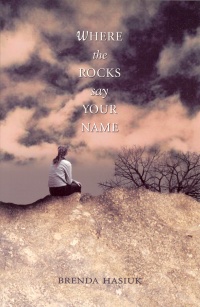| ________________
CM . . .
. Volume XIII Number 11 . . . .January 19, 2007 
 |
Where the Rocks Say Your Name.
Brenda Hasiuk.
Saskatoon, SK: Thistledown Press, 2006.
292 pp., pbk., $19.95.
ISBN 1-897235-11-9.
Grades 9-12 / Ages 14-17.
Review by Pam Klassen-Dueck.
*** /4
|
| |
|

excerpt:
"Is the sky always like this here?" she asked.
Although Adam could barely see her, he could still taste her cheeks, salty and soft. "How should I know?"
He said it with no anger in his voice. There in the shadows, he couldn't bring himself to break the spell.
For the first time that summer, Rina hugged herself in the night air, shivering in her thin T-shirt and bare legs. She wanted to lose herself in the faceless, endless stars, to cling to Adam in the awful darkness. She wanted to, but now that she'd left the brandy a stinking mess against Ruth's truck, she was nearly sober and the past would return unbidden and unwanted, like a pesky child who can't take a hint.
In the northern mining town of Franklin, Manitoba, in which all sounds seem to disappear into the woods, four teenagers swill beer and crack sunflower seeds during one last summer of adolescence. The lives of Ally and Toby, who grew up in Franklin, Rina, a refugee from Sarajevo, and Adam, a lost soul attempting to return to his native roots, intersect and explode in this raw land of harsh landscape and even harsher climate. Where the Rocks Say Your Name places under a microscope these four characters to examine the nuances of growing up in an industrial northern town in which the most exciting event is a local hockey match.
In this unusual coming-of-age story, friendships are not what sustain the characters as they move heartbreakingly out of adolescence. Paralleling the desolation of the Franklin area, in which extremes are pitted against each other, the friends and acquaintances of Where the Rocks Say Your Name break away from each other. Instead of leaning on each other for support, the characters' strength must be of an individual nature, as evidenced by Rina's return to her native city against the wishes of her parents. In the end, the novel suggests that the confused feelings and splintered friendships of Ally, Toby, Rina, and Adam seem to be inevitable rites of new adulthood.
The character in this novel who most stands out is the mysterious, complex, agitated character of Adam, who nearly jumps off of the pages of the book. His futile longing to return to his warrior roots in the rural landscape is acted out through destructive deeds such as shoplifting and a desire to murder. At the risk of reinforcing negative stereotypes of aboriginals, Adam's acts illustrate his rage against the injustices of the people who stole the land of his ancestors. For example, he sees mass-produced merchandise - "little pieces of a past that was his, but not his" - that dishonours his aboriginal past, his desire is to destroy the contents of the displays: "He'd light first the wood, then the bark, then the hides, until even the plastic had no choice but to melt away." Hasiuk does a fine job of portraying Adam's loss of a past that is simultaneously familiar and foreign to him.
However, the drunken date-rape scene featuring Adam and Rina (after the shocking death of one of the protagonists) is disturbing and confusing. Although it appears that the scene means a way for Adam to regain control over his disenfranchised past, this scene uses Rina as a scapegoat for colonial sins against the indigenous people of the so-called New World. Is this supposed to be a way for Adam to be repaid for the losses of his ancestors? And, if so, it is unclear why Rina, a recent immigrant from a war-torn area, must bear the blame for events that had nothing to do with her and her people. It is up to the reader to decide on the scene's value in context of the story.
The slow pace of Where the Rocks Say Your Name is not likely to attract reluctant readers. However, both the attention to character and the dreamy quality of the narrative make this atypical coming-of-age tale a good choice for enthusiastic high school readers who will appreciate this unshrinking portrayal of the transitions of early adulthood.
Recommended.
Pam Klassen-Dueck is a teacher and a graduate student in Winnipeg, MB.

To comment
on this title or this review, send mail to cm@umanitoba.ca.
Copyright © the Manitoba Library Association. Reproduction for personal
use is permitted only if this copyright notice is maintained. Any
other reproduction is prohibited without permission.
NEXT REVIEW |
TABLE OF CONTENTS FOR THIS ISSUE
- January 19, 2007.
AUTHORS |
TITLES |
MEDIA REVIEWS |
PROFILES |
BACK ISSUES |
SEARCH |
CMARCHIVE |
HOME |
